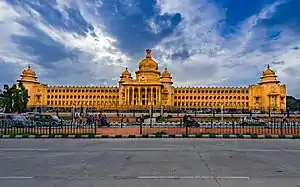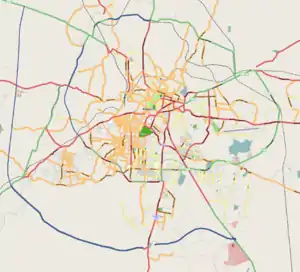Vidhana Soudha
The Vidhana Soudha in Bangalore is the seat of the bicameral state legislature of Karnataka.[1] It is constructed in a style sometimes described as Mysore Neo-Dravidian,[2] and incorporates elements of Dravidian styles.[3] The construction was completed in 1956.
| Vidhana Soudha | |
|---|---|
 Front facade of the Vidhana Soudha, seen from Dr. B. R. Ambedkar Road | |
 Location of Vidhana Soudha in Bangalore | |
| Alternative names | Karnataka State House |
| General information | |
| Type | Legislative building |
| Architectural style | Neo-Dravidian |
| Location | Bangalore, Karnataka |
| Country | India |
| Coordinates | 12.9796°N 77.5906°E |
| Construction started | 1952 |
| Completed | 1956 |
| Cost | ₹14.8 million (US$210,000) |
| Owner | Government of Karnataka |
| Height | 46 m (150 ft) |
| Technical details | |
| Size | 24 ha (60 acres) |
| Floor count | 4 + 1 basement |
| Floor area | 46,963 m2 (505,505 sq ft) |
| Design and construction | |
| Architect | B. R. Manickam, K. C. Reddy and Kengal Hanumanthaiya |
| Main contractor | KPWD |
| Other information | |
| Seating capacity | 300 members |
Construction history
Origin
Kengal Hanumanthaiah, who is credited with the conception of the Vidhan Soudha and under whose tenure the construction of Vidhan Soudha was overseen and completed.[4] The foundation stone was laid by the then Prime Minister of India, Jawaharlal Nehru and then chief minister K. C. Reddy, on 13 July 1951.[5] It was meant to dwarf the British-built Athara Kacheri (High Court) building.[6] Hanumanthaiah was criticized for the nearly ₹15 million (equivalent to ₹1.4 billion or US$19 million in 2019) spent to construct the building.[7], however the citizens of the state credit the building designed by him is an outstanding structure of Neo Dravidian style. The total area covered by Vidhan Soudha is 24 hectares (60 acres).
Design and construction
The Vidhana Soudha has four floors above and one floor below ground level and sprawls across an area of 213 by 107 metres (699 by 351 ft). It is the largest Legislative building in India. Its eastern face has a porch with 12 granite columns, 12 metres (40 ft) tall. Leading to the foyer is a flight of stairs with 45 steps, more than 61 metres (200 ft) wide. The central dome, 18 metres (60 ft) in diameter, is crowned by a likeness of the Indian national emblem.
The front of the building is inscribed with the slogan "Government's Work is God's Work," and the Kannada equivalent, "ಸರ್ಕಾರದ ಕೆಲಸ ದೇವರ ಕೆಲಸ" (sarkarada kelasa devara kelasa).[3] In 1957, the Mysore government planned to replace the inscription with Sathyameva Jayate, at a cost of ₹7,500 (equivalent to ₹610,000 or US$8,500 in 2019),[7] but the change did not take place. In 1996, the inscription inspired a visiting US state governor, George Voinovich of Ohio, to propose etching "With God, all things are possible" onto the Ohio Statehouse, prompting a high-profile lawsuit.[8]
The cost of construction at that time was just ₹17.5 million (equivalent to ₹1.6 billion or US$23 million in 2019). But presently, annual maintenance cost itself is more than ₹20 million (US$280,000) including repairs, painting, and other miscellaneous expenses.
The building is closed on Sundays and public holidays but it attracts high number of visitors on those days for its magnificent exterior and colorful evening lighting.
Security
The security of Vidhana Soudha is a fencing near the footpath on all sides. Then it was replaced with strong 3-metre-high (10 ft) steel fencing.[9][10] Consequently, watch towers, upgraded scanning equipment, automated doors and screening systems were installed.[11]
Vikas Soudha
The Karnataka government has constructed a replica named Vikas Soudha to the south of the building. Initiated by the then Chief Minister S. M. Krishna and inaugurated in February 2005, it is intended to be an annexe building, housing some of the ministries and legislative offices.
Location
It's located on Ambedkar Veedhi or Dr Ambedkar Rd, Seshadripuram.[12] Opposite to Vidhana Soudha is the High Court of Karnataka. Both buildings are in the Cubbon park which is located near the Karnataka State Lawn Tennis Association (KSLTA).
References
- "Vidhana Soudha, Bangalore".
- Lang, Jon T. (2002). A concise history of modern architecture in India. Orient Blackswan. pp. 40–41. ISBN 978-81-7824-017-6.
- "Soudha: A tale of sweat and toil". Deccan Chronicle. 31 October 2010. Retrieved 11 November 2010.
- Harish Ramaswamy; S. S. Patagundi; Shankaragouda Hanamantagouda Patil (2007). Karnataka government and politics. Concept Publishing Company. p. 61. ISBN 978-81-8069-397-7.
- "Not just brick and mortar". The Hindu. 12 September 2002. Retrieved 11 November 2010.
- Ranganna, T. S. (29 August 2012). "A wall at Vidhana Soudha demolished". The Hindu. Retrieved 15 February 2015.
- Kapoor, P. C., ed. (1957). "'Government's Work Is God's Work'—Inscription To Go". Civic Affairs. 5. Citizen Press. p. 44 – via Google Books.
The Mysore Government has decided to erase the inscription "Government work is God's work" on the facade of the Vidhana Soudha, the Rs. 1.5 crore colossal Legislature and Secretariat buildings... which has been a subject of considerable controversy. It is proposed to replace this inscription with another, Satyameva Jayate, which is inscribed under the Asoka Chakra in the national emblem. This change is expected to cost Rs. 7,500. The huge expenditure incurred for the construction of Vidhana Soudha had been the subject of considerable criticism both inside the Legislature and outside.
- American Civil Liberties Union v. Capitol Square Review, 20 F. Supp. 2d 1176 (S.D. Ohio 1998).
- "Vidhan Soudha to get steel fencing". The Hindu. 2 January 2002. Retrieved 11 November 2010.
- "Viviana Sousa to be fenced soon". The Hindu. 25 June 2002. Retrieved 11 November 2010.
- "More security for Viviana Soudha". The Times of India. 21 July 2005. Retrieved 11 November 2010.
- "Metro Green Line launch: No parking in CBD". The Hindu. 16 June 2017. Retrieved 27 June 2017.
External links
| Wikimedia Commons has media related to Vidhana Soudha. |